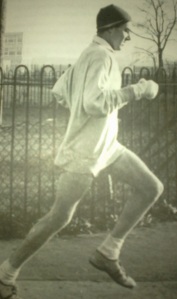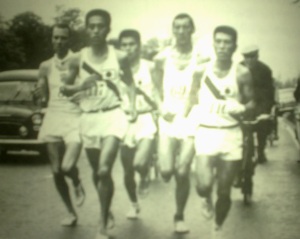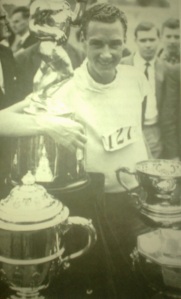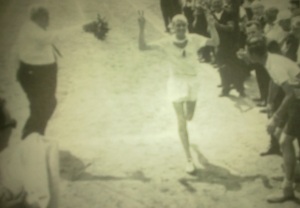America’s Buddy Edelen is one of marathons forgotten heroes, and is relatively unknown even in his homeland. What makes this so bizarre is the fact that in 1963, he became America’s first world record holder in the marathon since 1925 and thus became the nation’s first sub 2hr 20 and 2hr 15 marathoner.
Most runners will have heard of Frank Shorter or Bill Rodgers, but if one was to mention Buddy Edelen the common reply would be “Buddy who?”, a comical yet tragic quote that he used to joke about with his friend and former rival, Hal Higdon.
So why is Buddy Edelen such an unknown?
There are two main reasons; he spent his prime years (1960 – 1964) living and working in England, meaning that most of his phenomenal performances went unnoticed in the US. Another reason was the fact that he didn’t compete in the Boston marathon, which in those days, was “the” marathon to win and was virtually an unofficial world championship race.
Buddy’s unusual career had a straightforward start; he was a promising middle distance collegiate runner at the University of Minnesota and boasted solid personal bests of 4:29 for the mile and 9:03 for two miles in 1958. After graduating, Buddy was keen to carry on pursuing his running career and it was around this time that he met his coach and mentor, Fred Wilt.
Wilt was an ambitious coach who was hoping to spot talented young athletes with a strong work ethic in a bid to improve the standard of distance running in the States, which had fallen behind world standards over the past 20 years. He was influenced by the tough training regimes of Jim Peters and Emil Zatopek in the 1950’s. His idea was simple but brutal; Zatopek sessions of high intervals, Peters’ regular hard running at race pace, along with a weekly long run close to marathon distance on the road. In Buddy Edelen, he had a runner who could put those ideas into practice.
After meeting Fred Wilt, Edelen’s life started to take a completely different path. At his coach’s suggestion, he moved to Finland and trained out there for a few months, so that he could train and race with better runners whilst doing placement work as a teacher. Shortly after, he had an opportunity to teach in London and after consulting Wilt, was urged to do so as it would be perfect for his running.
It was 1960 and Britain was the leading nation in distance running after a post war boom in all events from the half-mile to marathon. Buddy embraced the British tradition of cross country running and initially fellow rivals and spectators thought it was an interesting novelty witnessing an American competing on the boggy cross country courses in a harsh winter, but it wasn’t long before he was a genuine threat in the big races. Edelen kept a thorough training diary and would post off his weekly training to his coach, which would duly be sent back with detailed feedback and plans for future schedules. Wilt was very impressed with his progress; he was now doing over 100 miles per week consistently and was competing with some of Britain’s best on their home turf.
His performances on the track had also improved and he managed to be the first American to beat the modest mark of 30 minutes for 10k. Despite establishing himself as a competent runner at world level, his exploits went largely unnoticed across the pond.
It wasn’t long before Edelen attempted his first marathon, which proved to be an unpleasant experience due to naive preparation, largely due to doing two tough sessions in the final week and an ill-advised smoked mackerel lunch on the day of the race! He staggered in with 2hr 31, over 10 minutes behind the winner, Ron Hill. Determined to make amends, he signed up for the Welsh marathon a month later and his form was good, in the lead up to the race he ran a solid 28:26 in the AAA’s six-mile championships, whilst it only gave him 9th place, it did give him a new US record.
In the final week, he still did sessions on Tuesday (40x 400m in 73’s) and Wednesday (2x 2 mile: 9:54, 9:57), though not as hard as previously. He then rested on Thursday and Friday and avoided mackerel before the race. His main rival would be Salford Harrier’s notorious runner, John Tarrant. The pace was initially reserved, covering the first 5 miles in 29:41, then it picked up with Edelen and Tarrant pulling away from the rest of the field. After 15 miles, Edelen made his move and was out in front on his own, he went on to win in 2hr 22:33, just a few seconds off Jim Peters’ course record.
With renewed confidence, Buddy started to focus more on the marathon. He got an invite to compete in the Kosice marathon in October 1962 and he ran solidly in windy conditions only losing out on victory in a sprint finish against Kantorek in 2hr 28:29. Only a couple of months later, he was competing in the Fukuoka marathon. Mamo Wolde set off at a fast pace, 30k was passed in 1hr 37:33 with Edelen only 50 seconds behind in 3rd. Buddy held on to 3rd, just finishing ahead of Kantorek by one second in 2hr 18:56, the first time an American had broken 2hr 20!
Things got even better in 1963, he ran in the AAA’s 10 mile in a tough battle against Mel Batty, the first mile was covered in 4:41 and halfway was reached in a blistering 23:59. Edelen couldn’t stay with Batty in the final stages, but held it together to finish less than 20 seconds behind in 48:28, which again, was another US record. Later in April he went on to win the Finchley 20 comfortably in 1hr 45:12. By now he was up there with the world’s best and had high hopes of competing in the much coveted Boston marathon, it would be the perfect opportunity to garner some much deserved recognition from his home nation. Unfortunately the organiser, Jock Semple was unable to raise enough funds and Buddy couldn’t afford the cost of arranging his own travel across. He did get an invite to compete in the Athens marathon, which obviously had a huge amount of prestige, but with a course record of 2hr 23:44 set by Bikila, it clearly wasn’t a fast course.
Edelen felt he had a chance of bagging the record and he reached 30k out in front and on schedule in 1hr 42. He ran the next 12k solidly and just about managed the record in 2hr 23:06, his best result to date. Next month was the Polytechnic marathon and he would be up against defending champion Ron Hill, who finished well ahead of him last year. This time Buddy was a very different marathoner and was prepared to go out at whatever pace was necessary. 5 miles was reached in 26:15 and 10 miles was passed in 52:20. The race was shaping up as a battle between Edelen, Hill and Juan Taylor, with the group picking up the pace, passing 15 miles in 1hr 17:03. Shortly after, Edelen started to pull clear with Hill trying to give chase, but Buddy was still increasing the gap, which had extended to nearly two minutes by 21 miles (1hr 47:55). He went on to finish in 2hr 14:28, not only was it a course record, but he’d knocked 47 seconds off the world record! It had been nearly 40 years since an American last achieved this momentous feat!
Not one to rest on his laurels, Edelen then went on to compete in the Kosice marathon again and this time he came out a convincing winner, setting a course record that would last for over 20 years. This phenomenal running still didn’t seem to impress the AAU (American Athletic Union) enough to allow Edelen to miss the US trails for the Tokyo Olympics; he would have to compete and win the Yonkers marathon. Whilst this may have seemed a straight-forward task, Edelen had a huge disadvantage against the other Americans; the most obvious one being that he’d have to travel thousands of miles on a budget with limited time off work. Not only this, but he’d have to acclimatise to the hot conditions, something that would be difficult when living in England. His way of dealing with the latter issue was to train heavily layered up in long sleeve tops and sweatshirts with jogging pants when out running, with the aim of getting used to running hard and being uncomfortably hot!
There was still plenty more racing throughout 1963 and within a couple of months he set another American record for 6 miles, running 28:00 for 4th in the AAA’s. The next marathon was Kosice in October, where he would be up against previous world record holder Sergey Popov of the Soviet Union and Britain’s Basil Heatley. There was also two Ethiopians running, Biratu Wami and Demissie Wolde. For the first 20k, the race was being disputed by these five competitors, but shortly after half-way, Popov was dropped. The Ethiopians constantly threw in 200 yard surges and managed to drop all but Edelen and in the last few miles, he unleashed a surge of his own, pulling away to win in 2hr 15:09, a course record that would last until 1978. It was a performance that Buddy rated as being better than his world record run, due to the nature of the course and the tough competition.
1964 would be the biggest year of his career; all the training and racing he had done was geared towards the Olympics in Tokyo, and the ultimate goal was the gold medal. First he would have to make the team, world record holder or not, for an American runner to represent their country they had to qualify for the team in a trial. This year it would be in the Yonkers marathon, in temperatures likely be in excess of 85 degrees Fahrenheit. The race was in May, so Edelen got to it and prepared as best he could, which meant running over 135 miles per week. Though it seemed crazy, it clearly worked; as it was indeed very hot in the race; 91 degrees Fahrenheit! He would be up against America’s finest; Johnny Kelley, who was still only 33 years old despite being a class marathoner for nearly a decade, who had an incredible record of eight consecutive wins in this race. The conditions forced the race to a cautious start and 10 miles was covered in a reserved 55 minutes. Edelen then started to increase the pace and moved away from Kelley and Hal Higdon with Norm Higgins managing to stay close to him until 15 miles, but then ended up blacking out after 20 miles! Edelen still didn’t let up and finished well in 2hr 24:25, but the statistics that really impress was that he won by a whole 20 minutes from Adolph Gruber and Johnny Kelley, and out of the 128 competitors only 37 finished!
Now Tokyo bound and one of the favourites for the gold medal in October, Edelen received some much deserved recognition from the American press. Sadly it was after the Yonkers marathon that things would start to go wrong. In that summer he started get niggles and twinges in his hips, legs and lower back, which was starting to hamper his training; the early signs of sciatica. It meant that Edelen was going into the Olympic marathon with less than ideal preparation; June and July was patchy by his standards and he was only able to get together some consistent training by late August.
By the time of the race, Edelen felt he was close to his best form, but the injury issues had planted a seed of doubt. The biggest threat was the defending champion, Abebe Bikila from Ethiopia. Australia’s track star, Ron Clarke took the field through 5k in 15:06, then 10k in 30:14. Bikila started to take over at 15k (45:35). Over a minute behind was Edelen, struggling with his sciatica and finding the pace tough. Bikila started to edge away from the field with only Jim Hogan giving chase at 20k (60:58), halfway was reached in a rapid 64:28, well under world record pace. Hogan gamely held on until 35k, when he ran himself to a standstill and was unable to finish. Buddy was managing to move through, but a medal was starting to look unlikely. By the end he managed to claw his way back to 6th in 2hr 18:24, but it was a distant six minutes behind Bikila who ran a new world record of 2hr 12:11. Britains Basil Heatley was 2nd in 2hr 16:19 and Japan’s Tsuburaya was 3rd in 2hr 16:22.
The sciatica continued to be a problem; in 1965 he won the Kefield marathon in Germany comfortably in a routine 2hr 21. Then it was another crack at the Polytechnic marathon, which would be a showdown against three Japanese runners; Teresawa, Shigematsu and Okabe. There would be no Ron Hill, Heatley (who retired) or Brain Kilby, so the British support was for the resident American. Early on Edelen fought hard to keep with the Japanese runners; 15 miles was covered in just over 1hr 15 and by 16 miles he could hold on no longer. Shigematsu won in 2hr 12 flat, a new world record with Terasawa 2nd in 2hr 13:41. Edelen finished 3rd in 2rh 14:34, only six seconds off his personal best, but it came with a heavy price; he later stated he “died a thousand deaths” in that race and the sciatica was terribly painful between 10 and 16 miles.
After five years in England, it was time for Buddy Edelen to return to the US, but by then his injury troubles only worsened. In 1966 he won the Denver marathon, despite the altitude and the conditions, it must still have been a very depressing result to cross the line in 2hr 51. It was the final nail in the coffin for Buddy, after all the hard work, his body couldn’t take anymore. The sub 2hr 15 result in London 12 months ago seemed a distant memory. It would prove to be his last race, and as with many class athletes, the final result didn’t do justice to such a great champion.
After his running career ended, he taught Psychology at Adams State, Colorado for a number of years. His life ended tragically short by cancer in 1997, he was just 59 years old.
Training
Edelen’s training was ahead of it’s time and one of the earliest examples of mixing fast paced runs, long runs and high interval sessions into a regime of over 130 miles per week. Even in the present day, his training is still relevant and provides a great example of how someone can run sub 2hr 15 marathons whilst holding down a full-time job. Here’s an example from 1963, the two weeks leading up to his world record:
Sun 2nd June: 11 miles steady road run. Mon 3rd: 23 miles steady in 2hr 04. Tue 4th: Session: 7 x (55 yrd jog, 55 yrd sprint, 110 jog, 110 sprint, 150 jog, 150 sprint, 220 jog, 220 sprint. Wed 5th: 11 miles in 55 minutes. Thur 6th: am: 6 miles hard. pm: Session: 4 x (440 yrd fast, 440 jog, 440 fast, 330 jog, 440 fast, 220 jog, 440 fast, 110 jog, 440 fast, 5 min walk). Averaged 64 secs on reps. Fri 7th: 20x 440 yrd (70 – 71) with 45 sec jog between each. Sat 8th: Club Match, Harlow: 1 mile (2nd in 4:23), 880 yrd (3rd, 2:07), then a 110 yrd leg in relay.
Sun 9th June: 23 miles in 2hr 01. Mon 10th: 4.5 miles home steady. Tue 11th: am: 4.5 miles to work fast. pm: Session: 25 x 440 yrd (66 / 67’s) with 220 jog between. Wed 12th: am: 4.5 miles to work. pm: 11 miles hard in 56 minutes. Thur 13th & Fri 14th: Rest. Sat 15th: Polytechnic Marathon, 1st, 2hr 14:28.
In 1964, a typical week looked like this:
Sun 23rd May: 28 miles in 2hr 39. Mon 24th: Rest. Tue 25th: am: 4.5 miles to work. pm: Session: 20x 440 yrd in 69-70 secs. 220 jog between. Wed 26th: am: 4.5 miles to work. pm: 15 miles in 1hr 18. Thur 27th: am: 4.5 miles to work. pm: Session: 25 x 220 fast with 220 jog. Fri 28th: am: 4.5 miles to work. pm: 11 miles in 58 minutes. Sat 29th: am: Session: 5 x 110 yard sprints, 10 x 770 yards in 1:55 with 350 slow jog between. pm: Session: 15x 150 yrd strides on grass.
Performances
6 miles: 28:00
10 miles: 48:28
Marathon: 2hr 14:28
Further Reading
In 1992, Frank Murphy published a biography of Buddy Edelen titled, “A Cold Clear Day” which I would highly recommend. It’s certainly due a reprint, but it is still quite easy to get hold of. It provides a wealth of information regarding his training, which I have given examples of in this article. It’s a book that’s clearly written by a runner for runners! There’s also a brief profile of Edelen in Tim Noakes’ runners bible; The Lore of Running.





I just wanted to say..I knew Buddy…as a high school distance runner in Alamosa, Colorado in the 1960’s I met buddy in 1965, one day on the road, seemingly just two runners who loved to run. We ran mile after mile until we ended our run that day…Silent, the two of us pushing each other. He was past his prime by then…but still had hopes of earning a medal at the 68′ Mexico games. . A humble man as I ever met. He invited me to run with him during his after noon runs. He understood back then, the roads were empty of other runners and it got lonely and a training partner was refreshing. Buddy taught me his training techniques and cross training principles that helped me excel in my own right. He taught about the four phases of training, and encouraged me more than anyone to keep the faith and enjoy the run. I will never forget that experience. Two years we ran together often…and before the entering into my senior years of high school, through his coaching and mentor ship he helped me unofficially-break both the mile and two mile Colorado state records with times of 4:17, and 9:11, before going into the fall cross country season.
Unfortunately just days later I severally injured my ankle playing basketball- with torn ligaments in my right foot, I would not be able to run for months. So discouraged after nearly two years of daily training I never really recovered emotionally…before I decided to join the army where I ended up going to Vietnam in 1968 just before the summer games. I knew that Buddy came to Alamosa because of the high altitude that was similar to Mexico City’s at, 7600 ft. above sea level. But more than this, the high altitude, Buddy told me would required less mileage than training at a lower altitude and this was to preserve unnecessary stress on an ailing back injury that had slowed him down in recent years, after setting the World Record and the first man to break 2:15 in the Marathon Still, Buddy had hope of reaching his dream of an Olympic Medal, but his back injury would not allow him to do so… This was a great disappointment to him as he told me later when I came home from Vietnam. But I will never forget him and what he taught me..and I would later use as a successful XC and Track coach working with Native American runners on the Navajo Reservation from 1980-2000…where my charges both male and female dominated the distance events at the state level. And perhaps the greatest of these achievements was when I was the boys coach for an All Native American team-Wings of the Southwest, who won the 1993 Jr. National Cross Country team title with a perfect score of 15. What made this event even more special was that my high school and college coach Dr. Joe I. Vigil was in attendance and we got to reminiscence about Buddy, also a close friend of his- and we both honored Buddy’s influence on Distance Running in Alamosa, where Coach Vigil’s teams dominated the national cross country scene for years, and where he himself became a distance coaching legend. Here’s to Buddy, my good friend, mentor and the most dedicated runner I had ever met…
Thanks for your contribution James. It’s great to hear from someone who’s had the pleasure of knowing him and has been inspired to go on to being a great coach. Here’s to Buddy indeed, one of the greats, never to be forgotten.
Great article on Buddy, well researched and written… Heard of him when I was a kid growing up and running as a teen-here in Canada. A man few remember, and sadly UNKNOWN in America his home country….Long May We Run…
Gary
Thanks Gary. It is sad that very little gets written about him. Hopefully A Cold Clear Day will get republished someday, he was a phenomenal runner.